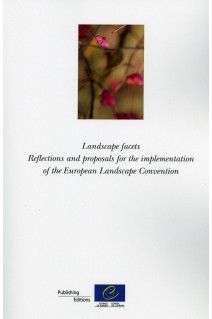



The European Landscape Convention was adopted under the auspices of the Council of Europe with the aim of promoting the protection, management and planning of European landscape and organising European co-operation in this area. It is the first international treaty covering all aspects of landscape. It applies to the entire territory of the contracting parties and covers natural, rural, urban and peri-urban areas. It concerns landscapes that might be considered outstanding, commonplace or deteriorated. The convention represents an important contribution to achieving the Council of Europe's objectives, namely to promote democracy, human rights and the rule of law, as well as to seek common solutions to the main problems facing European society. By taking into account landscape, culture and nature, the Council of Europe seeks to protect the quality of life and well-being of Europeans in a sustainable development perspective.
Preface
I. Landscape, towns and peri-urban and suburban areas
Summary
Introduction: purpose of the study
1. Concepts of peri-urban and suburban landscapes
2. Examples of peri-urban and suburban landscapes
3. "Landscape" in selected town planning policies
4. "Urban landscape" in selected town planning policies
5. Co-operative and communicative planning and decision making
Conclusions
II. Infrastructure and landscape: roads
Summary
Introduction: travelling, landscape experience and roads
1. Roads and landscapes
2. Landscape perception from the road
3. Road design for landscape character
4. Road integration within landscape
Conclusions: landscape values on every road
Appendices
Sources
III. Road infrastructures: tree avenues in the landscape
Summary
Introduction
1. History
2. A multifaceted heritage
3. What is to be done?
4. Regulatory protection: the key to success
5. What resources?
Conclusions and recommendations
Appendices
Photo credits
Sources
IV. European local landscape circle studies: implementation guide
Summary
Introduction
1. Aims of the landscape circle template
2. The steps
Appendices
Acknowledgements
V. Education on landscape for children
Summary
1 . Education on landscape and education for sustainable development
2. Discovering education on landscape
Conclusions and recommendations: promotion of education on landscape
VI. Training of landscape architects
Introduction.
1. What is landscape architecture?
2. Why is landscape architecture education important for the European Landscape Convention?
3. Evolution of landscape architecture education in Europe
4. Current state of education in landscape architecture in Europe
5. Analysis and discussion
Conclusions and recommendations
Acknowledgements
VII. Landscape and ethics
Introduction
1. Legislation, common law and beliefs
2. Ethics and landscape preservation
3. International politics and ethics
4. The Council of Europe European Landscape Convention
5. The United Nations Convention on Biological Diversity
6. Professional ethics for territories
Conclusions: a harmonious development

The European Landscape Convention was adopted under the auspices of the Council of Europe with the aim of promoting the protection, management and planning of European landscape and organising European co-operation in this area. It is the first international treaty covering all aspects of landscape. It applies to the entire territory of the contracting parties and covers natural, rural, urban and peri-urban areas. It concerns landscapes that might be considered outstanding, commonplace or deteriorated. The convention represents an important contribution to achieving the Council of Europe's objectives, namely to promote democracy, human rights and the rule of law, as well as to seek common solutions to the main problems facing European society. By taking into account landscape, culture and nature, the Council of Europe seeks to protect the quality of life and well-being of Europeans in a sustainable development perspective.
Attention, en vertu de nos conditions générales de vente, l'achat des PDF/epub est réservé aux particuliers.
